英语专八人文-最全语言学知识点
- 格式:docx
- 大小:86.21 KB
- 文档页数:10
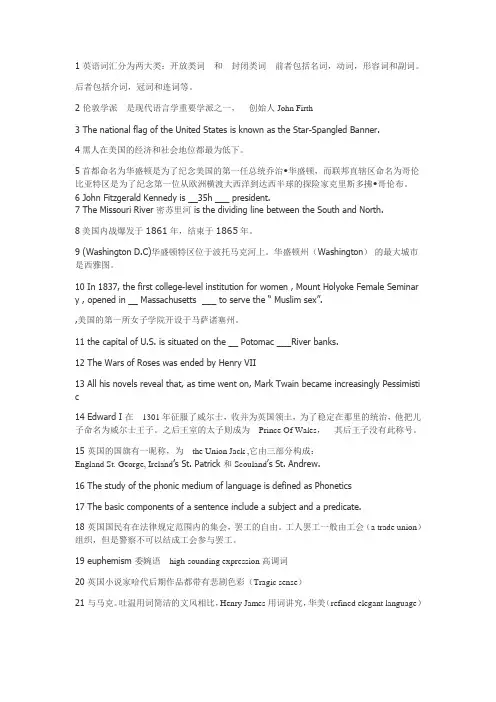
1 英语词汇分为两大类:开放类词和封闭类词前者包括名词,动词,形容词和副词。
后者包括介词,冠词和连词等。
2 伦敦学派是现代语言学重要学派之一,创始人John Firth3 The national flag of the United States is known as the Star-Spangled Banner.4黑人在美国的经济和社会地位都最为低下。
5首都命名为华盛顿是为了纪念美国的第一任总统乔治•华盛顿,而联邦直辖区命名为哥伦比亚特区是为了纪念第一位从欧洲横渡大西洋到达西半球的探险家克里斯多拂•哥伦布。
6 John Fitzgerald Kennedy is __35h ___ president.7 The Missouri River 密苏里河 is the dividing line between the South and North.8美国内战爆发于1861年,结束于1865年。
9 (Washington D.C)华盛顿特区位于波托马克河上。
华盛顿州(Washington)的最大城市是西雅图。
10 In 1837, the first college-level institution for women , Mount Holyoke Female Seminar y , opened in __ Massachusetts ___ to serve the “ Muslim sex”.,美国的第一所女子学院开设于马萨诸塞州。
11 the capital of U.S. is situated on the __ Potomac ___River banks.12 The Wars of Roses was ended by Henry VII13 All his novels reveal that, as time went on, Mark Twain became increasingly Pessimistic14 Edward I 在1301年征服了威尔士,收并为英国领土,为了稳定在那里的统治,他把儿子命名为威尔士王子。
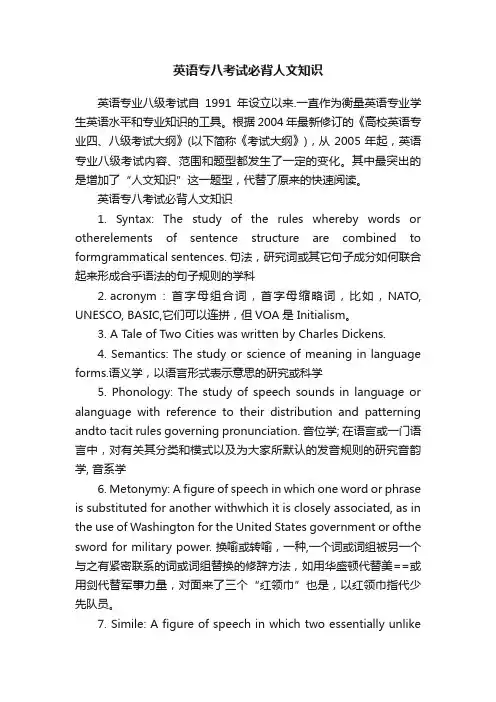
英语专八考试必背人文知识英语专业八级考试自1991年设立以来.一直作为衡量英语专业学生英语水平和专业知识的工具。
根据2004年最新修订的《高校英语专业四、八级考试大纲》(以下简称《考试大纲》),从2005年起,英语专业八级考试内容、范围和题型都发生了一定的变化。
其中最突出的是增加了“人文知识”这一题型,代替了原来的快速阅读。
英语专八考试必背人文知识1. Syntax: The study of the rules whereby words or otherelements of sentence structure are combined to formgrammatical sentences. 句法,研究词或其它句子成分如何联合起来形成合乎语法的句子规则的学科2. acronym : 首字母组合词,首字母缩略词,比如,NATO, UNESCO, BASIC,它们可以连拼,但VOA是 Initialism。
3. A Tale of Two Cities was written by Charles Dickens.4. Semantics: The study or science of meaning in language forms.语义学,以语言形式表示意思的研究或科学5. Phonology: The study of speech sounds in language or alanguage with reference to their distribution and patterning andto tacit rules governing pronunciation. 音位学; 在语言或一门语言中,对有关其分类和模式以及为大家所默认的发音规则的研究音韵学, 音系学6. Metonymy: A figure of speech in which one word or phrase is substituted for another withwhich it is closely associated, as in the use of Washington for the United States government or ofthe sword for military power. 换喻或转喻,一种,一个词或词组被另一个与之有紧密联系的词或词组替换的修辞方法,如用华盛顿代替美==或用剑代替军事力量,对面来了三个“红领巾”也是,以红领巾指代少先队员。
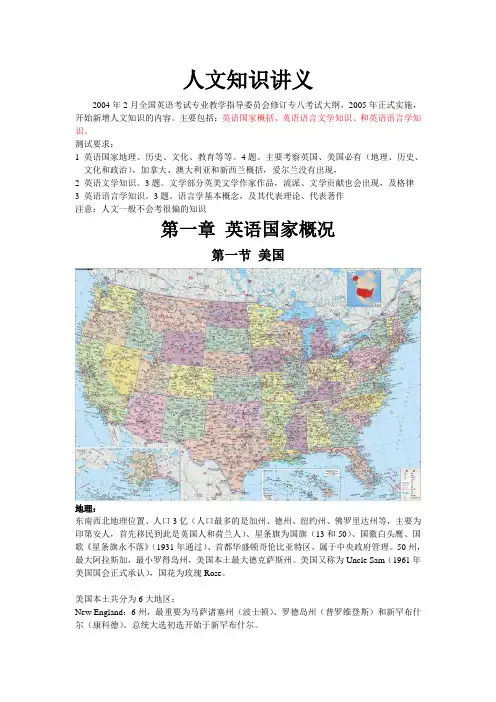
人文知识讲义2004年2月全国英语考试专业教学指导委员会修订专八考试大纲,2005年正式实施,开始新增人文知识的内容。
主要包括:英语国家概括、英语语言文学知识、和英语语言学知识。
测试要求:1 英语国家地理、历史、文化、教育等等。
4题。
主要考察英国、美国必有(地理、历史、文化和政治),加拿大、澳大利亚和新西兰概括,爱尔兰没有出现,2 英语文学知识。
3题。
文学部分英美文学作家作品,流派、文学贡献也会出现,及格律3 英语语言学知识。
3题。
语言学基本概念,及其代表理论、代表著作注意:人文一般不会考很偏的知识第一章英语国家概况第一节美国地理:东南西北地理位置、人口3亿(人口最多的是加州、德州、纽约州、佛罗里达州等,主要为印第安人,首先移民到此是英国人和荷兰人)、星条旗为国旗(13和50)、国徽白头鹰、国歌《星条旗永不落》(1931年通过)、首都华盛顿哥伦比亚特区,属于中央政府管理。
50州,最大阿拉斯加,最小罗得岛州,美国本土最大德克萨斯州。
美国又称为Uncle Sam(1961年美国国会正式承认),国花为玫瑰Rose。
美国本土共分为6大地区:New England:6州,最重要为马萨诸塞州(波士顿)、罗德岛州(普罗维登斯)和新罕布什尔(康科德)。
总统大选初选开始于新罕布什尔。
1 美国诞生地和独立战争的主要战场。
2 波士顿美国最古老的城市,有麻省理工学院和哈佛。
波士顿的龙虾很有名3 新英格兰人又称为yankees.the Middle Atlantic States: 7州、最重要的为纽约州、宾州、新泽西州和马里兰州。
1 白宫和国会山在华盛顿特区。
2 纽约是美国最大的城市,联合国大厦等等著名建筑在此。
共有5个区:分别是曼哈顿、皇后、布鲁克林、布朗克斯和斯塔滕岛。
有帝国大厦和自由女神像。
哥伦比亚大学和康奈尔大学。
纽约称为big apple。
3 尼亚加拉大瀑布在纽约州的水牛城。
4 葛底斯堡位于宾州,林肯曾在此发表过演讲。
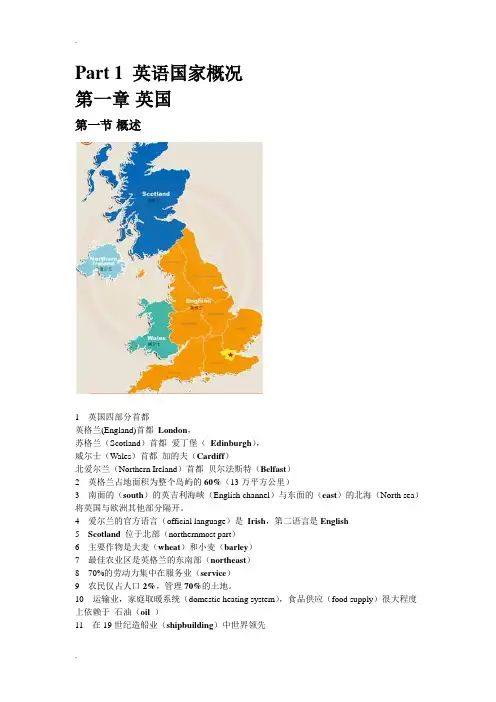
Part 1 英语国家概况第一章英国第一节概述1 英国四部分首都英格兰(England)首都London,苏格兰(Scotland)首都爱丁堡(Edinburgh),威尔士(Wales)首都加的夫(Cardiff)北爱尔兰(Northern Ireland)首都贝尔法斯特(Belfast)2 英格兰占地面积为整个岛屿的60%(13万平方公里)3 南面的(south)的英吉利海峡(English channel)与东面的(east)的北海(North sea)将英国与欧洲其他部分隔开。
4 爱尔兰的官方语言(official language)是Irish,第二语言是English5 Scotland 位于北部(northernmost part)6 主要作物是大麦(wheat)和小麦(barley)7 最佳农业区是英格兰的东南部(northeast)8 70%的劳动力集中在服务业(service)9 农民仅占人口2%,管理70%的土地。
10 运输业,家庭取暖系统(domestic heating system),食品供应(food supply)很大程度上依赖于石油(oil )11 在19世纪造船业(shipbuilding)中世界领先12 England 的人口最多第二节地理1 本尼维斯山(Ben Nevis)是英国最高的山(highest mountain)2 斯克菲尔峰(Scafell)是英格兰最高峰(highest peak)3 塞文河(Severn River)是英国最长的河(longest river)4 泰晤士河(Thames River)是英国第二大河和最重要的河流(second and most important river)5 内伊湖(Lough Neagh)是英国最大的湖(largest lake),位于北爱尔兰6 英吉利海峡(The English Channel)是分隔England和France的狭窄海道,连接大西洋(Atlantic ocean)与北海(North Sea)7 英国是海洋性气候(the maritime type),由于受墨西哥湾流(the Gulf Stream)的影响,比同纬度其他地方温度高(warmer),温和适中,冬天温和,夏天凉爽,天气多变(changeable),有时会在一天经历四季变化。
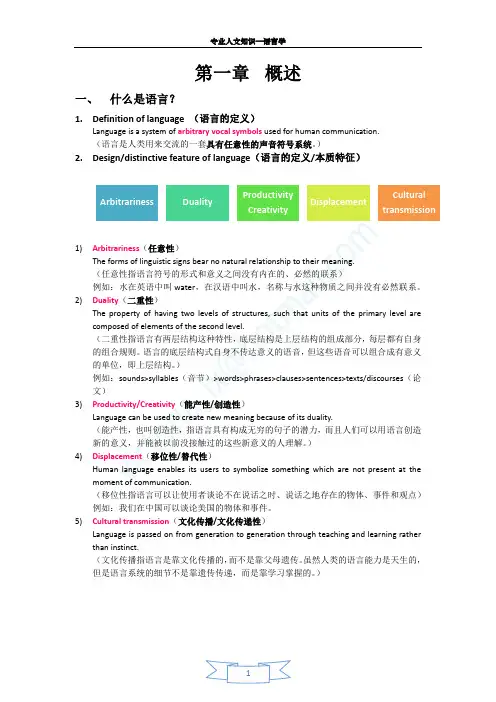
第一章概述一、什么是语言?1.Definition of language (语言的定义)Language is a system of arbitrary vocal symbols used for human communication.(语言是人类用来交流的一套具有任意性的声音符号系统。
)2.Design/distinctive feature of language(语言的定义/本质特征)1)2)3)4)(移位性指语言可以让使用者谈论不在说话之时、说话之地存在的物体、事件和观点)例如:我们在中国可以谈论美国的物体和事件。
5)Cultural transmission(文化传播/文化传递性)Language is passed on from generation to generation through teaching and learning rather than instinct.(文化传播指语言是靠文化传播的,而不是靠父母遗传。
虽然人类的语言能力是天生的,但是语言系统的细节不是靠遗传传递,而是靠学习掌握的。
)二、什么是语言学?Linguistics is a scientific study of language.(语言学是对语言的科学研究)语言学的研究对象不是某特定的语种,而是人类所有的语言,在考察分析大量语言现象的基础上总结语言规律。
语言学家想要回答的基本问题是:什么是语言?语言的机制是什么?人们是如何使用语言实现各种目的的。
三、语言学的重要概念1.descriptive vs. prescriptive(描述性与规定性)描述性研究是现代语言学家采取的基本立场,注重观察分析语言中的事实,目的通常是描述人们一般是怎么说话、写作的。
规定性研究注意总结语言中的标准,目的通常是规定人们应该如何说话、写作。
例如:规定只能用单数、复数2.synchronic vs. diachronic(共时性与历时性)synchronic: the study of a language through the course of its history(共时研究以某个特定时期的语言为研究对象)例如:莎士比亚时代语言研究diachronic: takes a fixed instant as its point of observation(历时研究则研究语言各个阶段的发展变化,研究语言的历史发展规律)ngue vs. parole(语言与言语)该区分是现代语言学鼻祖Saussure提出的。
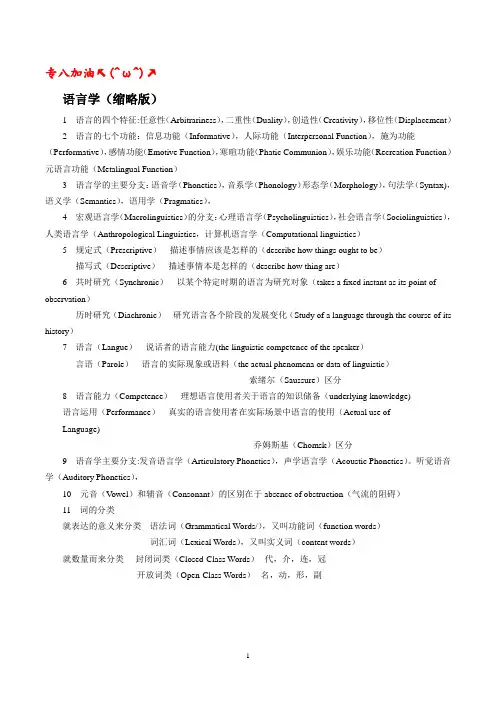
专八加油↖(^ω^)↗语言学(缩略版)1 语言的四个特征:任意性(Arbitrariness),二重性(Duality),创造性(Creativity),移位性(Displacement)2 语言的七个功能:信息功能(Informative),人际功能(Interpersonal Function),施为功能(Performative),感情功能(Emotive Function),寒暄功能(Phatic Communion),娱乐功能(Recreation Function)元语言功能(Metalingual Function)3 语言学的主要分支:语音学(Phonetics),音系学(Phonology)形态学(Morphology),句法学(Syntax),语义学(Semantics),语用学(Pragmatics),4 宏观语言学(Macrolinguistics)的分支:心理语言学(Psycholinguistics),社会语言学(Sociolinguistics),人类语言学(Anthropological Linguistics,计算机语言学(Computational linguistics)5 规定式(Prescriptive)---描述事情应该是怎样的(describe how things ought to be)描写式(Descriptive)---描述事情本是怎样的(describe how thing are)6 共时研究(Synchronic)---以某个特定时期的语言为研究对象(takes a fixed instant as its point of observation)历时研究(Diachronic)---研究语言各个阶段的发展变化(Study of a language through the course of its history)7 语言(Langue)---说话者的语言能力(the linguistic competence of the speaker)言语(Parole)---语言的实际现象或语料(the actual phenomena or data of linguistic)----索绪尔(Saussure)区分8 语言能力(Competence)---理想语言使用者关于语言的知识储备(underlying knowledge)语言运用(Performance)---真实的语言使用者在实际场景中语言的使用(Actual use ofLanguage)----乔姆斯基(Chomsk)区分9 语音学主要分支:发音语言学(Articulatory Phonetics),声学语言学(Acoustic Phonetics)。
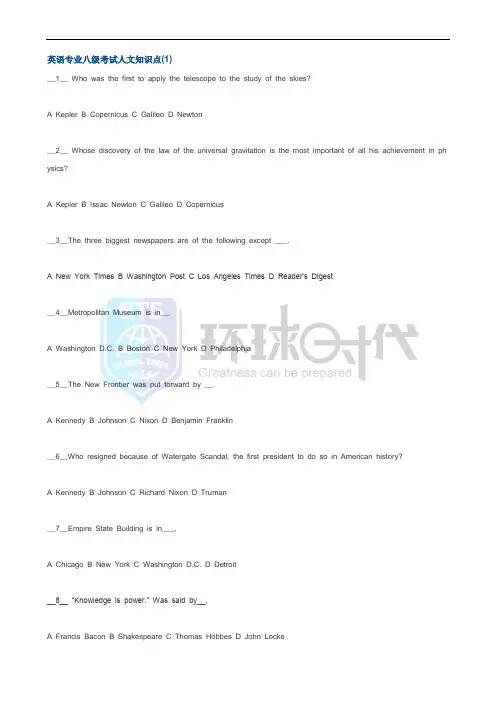
英语专业八级考试人文知识点(1)__1__ Who was the first to apply the telescope to the study of the skies?A KeplerB CopernicusC GalileoD Newton__2__ Whose discovery of the law of the universal gravitation is the most important of all his achievement in ph ysics?A KeplerB Issac NewtonC GalileoD Copernicus__3__The three biggest newspapers are of the following except ___.A New York TimesB Washington PostC Los Angeles TimesD Reader’s Digest__4__Metropolitan Museum is in__.A Washington D.C.B BostonC New YorkD Philadelphia__5__The New Frontier was put forward by __.A KennedyB JohnsonC NixonD Benjamin Franklin__6__Who resigned because of Watergate Scandal, the first president to do so in American history?A KennedyB JohnsonC Richard NixonD Truman__7__Empire State Building is in___.A ChicagoB New YorkC Washington D.C.D Detroit__8__ “Knowledge is power.” Was said by__.A Francis BaconB ShakespeareC Thomas HobbesD John Locke__9__Which of the following philosophers believed that man is selfish by nature?A John LockeB DescartesC Pierre GassendiD Thomas Hobbes__10__Jazz, a great contribution to the world popular music, was originated from the music of __.A IndiansB SpanishC NegroesD Portuguese答案解析:1选C。
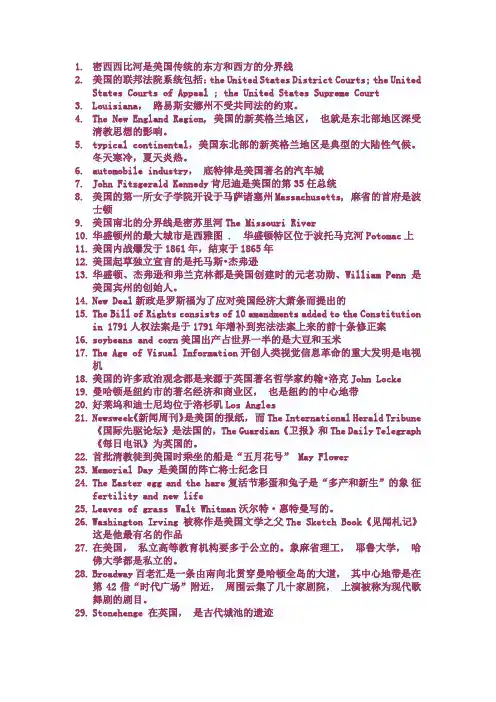
1.密西西比河是美国传统的东方和西方的分界线2.美国的联邦法院系统包括:the United States District Courts; the UnitedStates Courts of Appeal ; the United States Supreme Court3.Louisiana,路易斯安娜州不受共同法的约束。
4.The New England Region, 美国的新英格兰地区,也就是东北部地区深受清教思想的影响。
5.typical continental,美国东北部的新英格兰地区是典型的大陆性气候。
冬天寒冷,夏天炎热。
6.automobile industry,底特律是美国著名的汽车城7.John Fitzgerald Kennedy肯尼迪是美国的第35任总统8.美国的第一所女子学院开设于马萨诸塞州Massachusetts, 麻省的首府是波士顿9.美国南北的分界线是密苏里河The Missouri River10.华盛顿州的最大城市是西雅图 . 华盛顿特区位于波托马克河Potomac上11.美国内战爆发于1861年,结束于1865年12.美国起草独立宣言的是托马斯•杰弗逊13.华盛顿、杰弗逊和弗兰克林都是美国创建时的元老功勋、William Penn 是美国宾州的创始人。
14.New Deal新政是罗斯福为了应对美国经济大萧条而提出的15.The Bill of Rights consists of 10 amendments added to the Constitution in1791人权法案是于1791年增补到宪法法案上来的前十条修正案16.soybeans and corn美国出产占世界一半的是大豆和玉米17.The Age of Visual Information开创人类视觉信息革命的重大发明是电视机18.美国的许多政治观念都是来源于英国著名哲学家约翰•洛克John Locke19.曼哈顿是纽约市的著名经济和商业区,也是纽约的中心地带20.好莱坞和迪士尼均位于洛杉矶Los Angles21.Newsweek《新闻周刊》是美国的报纸,而The International Herald Tribune《国际先驱论坛》是法国的,The Guardian《卫报》和The Daily Telegraph 《每日电讯》为英国的。
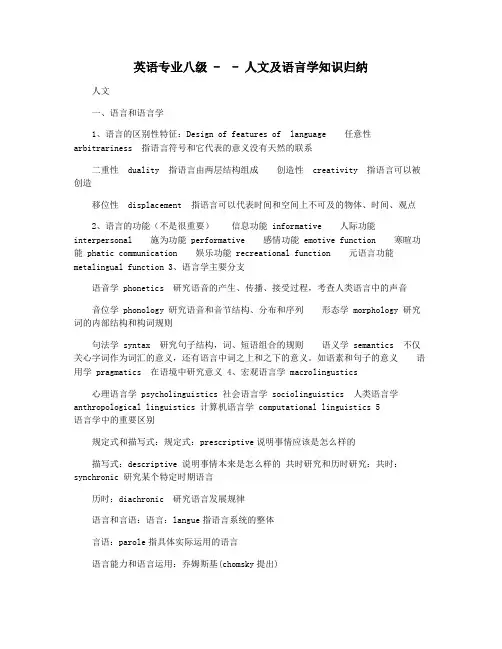
英语专业八级 - - 人文及语言学知识归纳人文一、语言和语言学1、语言的区别性特征:Design of features of language 任意性arbitrariness 指语言符号和它代表的意义没有天然的联系二重性 duality 指语言由两层结构组成创造性 creativity 指语言可以被创造移位性 displacement 指语言可以代表时间和空间上不可及的物体、时间、观点2、语言的功能(不是很重要)信息功能 informative 人际功能interpersonal 施为功能 performative 感情功能 emotive function 寒暄功能 phatic communication 娱乐功能 recreational function 元语言功能metalingual function3、语言学主要分支语音学 phonetics 研究语音的产生、传播、接受过程,考查人类语言中的声音音位学 phonology 研究语音和音节结构、分布和序列形态学 morphology 研究词的内部结构和构词规则句法学 syntax 研究句子结构,词、短语组合的规则语义学 semantics 不仅关心字词作为词汇的意义,还有语言中词之上和之下的意义。
如语素和句子的意义语用学 pragmatics 在语境中研究意义 4、宏观语言学 macrolingustics心理语言学 psycholinguistics 社会语言学 sociolinguistics 人类语言学anthropological linguistics 计算机语言学 computational linguistics 5 语言学中的重要区别规定式和描写式:规定式:prescriptive说明事情应该是怎么样的描写式:descriptive 说明事情本来是怎么样的共时研究和历时研究:共时:synchronic 研究某个特定时期语言历时:diachronic 研究语言发展规律语言和言语:语言:langue指语言系统的整体言语:parole指具体实际运用的语言语言能力和语言运用:乔姆斯基(chomsky提出)能力:competence用语言的人的语言知识储备运用:performance 真实的语言使用者在实际中的语言使用二、语音学1、语音学分支发音语音学articulatory phonetics研究语言的产生声学语言学acoustic phonetics 研究语音的物理属性听觉语音学 auditory phonetics 研究语言怎样被感知 2 IPA(国际音标)是由daniel Jones琼斯提出的三、音位学1、最小对立体minimal pairs2、音位 phoneme 3 音位变体 allophones4 互补分布 complementary distribution5 自由变体 free variation6 区别特征 distinctive features7 超音段特征 suprasegmental feature音节 syllable 重音stress 语调tone 声调intonation 四形态学 1 词的构成语素morpheme 自由语素free morpheme 粘着语素bound morphemeRoot 词根词缀affix 词干stem屈折词汇和派生词汇 inflectional affix and derivational affix2 特有的词汇变化lexical change proper新创词语invention 混拼词blending 缩写词abbreviation首字母缩写词 acronym 逆构词汇back-formation例:editor―edit类推构词analogiacal creation 例:work-worked,,slay-slayed外来词 borrowing 五句法学1 范畴category 数number 性gender 格case 时tense 体aspect一致关系concord 支配关系govenrment 2 结构主义学派the structure approach组合关系 syntagmatic relation词和词组合在一起聚合关系 paradigmatic 具有共同的语法作用的词聚在一起结构和成分 construction and constituents :句子不仅是线性结构liner structure还是层级结构hierarchical structure (句子或短语被称为结构体,而构成句子或短语即结构体的称为成分)3 直接成分分析法 immediate constitutional analysis 指把句子分成直接成分-短语,再把这些短语依次切分,得到下一集直接成分,这样层层切分,直到不能再分4 向心结构和离心结构endocentric and exocentric constructions向心:指一个结构中有中心词,例an old man ,中心为man 离心:指结构中没有明显的中心词。

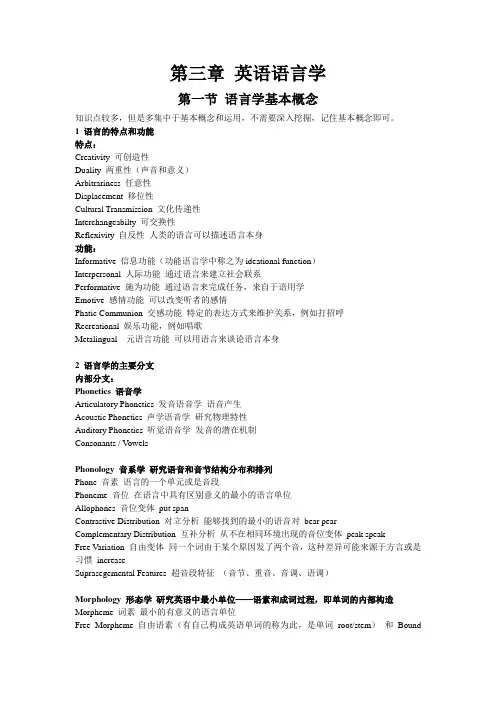
第三章英语语言学第一节语言学基本概念知识点较多,但是多集中于基本概念和运用,不需要深入挖掘,记住基本概念即可。
1 语言的特点和功能特点:Creativity 可创造性Duality 两重性(声音和意义)Arbitrariness 任意性Displacement 移位性Cultural Transmission 文化传递性Interchangeabilty 可交换性Reflexivity 自反性人类的语言可以描述语言本身功能:Informative 信息功能(功能语言学中称之为ideational function)Interpersonal 人际功能通过语言来建立社会联系Performative 施为功能通过语言来完成任务,来自于语用学Emotive 感情功能可以改变听者的感情Phatic Communion 交感功能特定的表达方式来维护关系,例如打招呼Recreational 娱乐功能,例如唱歌Metalingual 元语言功能可以用语言来谈论语言本身2 语言学的主要分支内部分支:Phonetics 语音学Articulatory Phonetics 发音语音学语音产生Acoustic Phonetics 声学语音学研究物理特性Auditory Phonetics 听觉语音学发音的潜在机制Consonants / VowelsPhonology 音系学研究语音和音节结构分布和排列Phone 音素语言的一个单元或是音段Phoneme 音位在语言中具有区别意义的最小的语言单位Allophones 音位变体put spanContrastive Distribution 对立分析能够找到的最小的语音对bear pearComplementary Distribution 互补分析从不在相同环境出现的音位变体peak speakFree Variation 自由变体同一个词由于某个原因发了两个音,这种差异可能来源于方言或是习惯increaseSuprasegemental Features 超音段特征(音节、重音、音调、语调)Morphology 形态学研究英语中最小单位——语素和成词过程,即单词的内部构造Morpheme 词素最小的有意义的语言单位Free Morpheme 自由语素(有自己构成英语单词的称为此,是单词root/stem)和BoundMorpheme 粘连语素(需要和自由语素联合构成单词的称为此,是词缀,进一步分为Inflectional Affixes 屈折词缀,在现代英语中主要指单复数,时态比较级等等和Derivational Affixes 派生词缀,这是形成新词的关键)。
第一章英语国家概括第一节英国概括I地理有四个部分组成great Britain (England ,Wales,Scotland)and northern Irelandn地理特征最短的海峡strait of Dover多佛海峡1 England the pennies 英格兰最主要的山脉2 Scotland three natural zone :the highlands central lowlands the southern uplands ,首都是Edinburgh ,river Clyde 克莱德河是最重要的河流,3 Wales Cardiff 最大的城市和首府4 northern Ireland Belfast 英国最大的湖是内伊湖(Lough Neagh)5 Rivers and lakes最长的是Severn river (赛文河),第二长和最重要的是泰晤士河,(Thames river),典型的海洋性气候(maritime climate )川人口60million ,英国人是Anglo-Saxons ,苏格兰人hospitable and generous, Wales are emotional and cheerful people,北爱尔兰的官方语言是爱尔兰语,其次才是英语ethic groups 伦敦是最大的少数名族聚居区IV History :1 first settlers are Lberians (伊利比亚人)2 1066(Norman conquer)1215 (大宪章)1337—1453(英法百年战争)1381(农民起义)1458(玫瑰战争, 1350-1650(Renaissance)1642-1646 (first civil war ), 1658(the restoration 王朝复辟)1688(the glorious revolution )V教育实行的是5-16岁都必须前去学习W Religio nEstablished churches 分为the Church of England (official church ,英国君主必须是这个教的成员主教和大主教由monarch 指定)and the Church of Scotland (Presbyterian , 长老教会)Unestablished churches: the Anglican churches 英国圣公会, the free churches 自由教, the roman catholic church 天主教vn 主要节日Christmas day December 25 th Easter 复活节(主要的天主教节日)whit Sun day (圣灵降临节,复活节后的第7个周日)Gay Fawkes day (盖伊福克斯之夜, 11月5日, 燃放烟火的节日)忸sports,足球是最受欢迎的(职业足球从August至U May),最典型的英国运动是cricket ,板球)网球(annual Wimbledon fortnightIX Arts 博物馆(the British museum, the national history museum .the national army museum ,the national gallery )Music (甲壳虫乐队,the Beatles ,first national music day was held in 1992,the most famous music festival is the Edinburgh international festival of music and dramaX media (BBC ,daily Express Daily mail daily mirror , daily star ,finan cial times ,the Guardia n, the times (泰晤士报)the observer (the first Sunday newspaper)幻Politicalconstitutional monarchy ,没有宪法,全靠惯例,parliament (the house of lord and the house of commons ,任期为五年)political party :labor party(Whigs 辉格党) and conservative party ( Tories 托利党) 第二节美国概括I yellow National park (大平原地带),大峡谷 (the grand canvon ,in Arizona ,phoenix is thelargest city in the intermountain region ,the largest commercial city( san Francisco, also the second largest city in California )n Alaska and Hawaii (Alaska 居住着Inuits , also called Eskimos)Hawaii ( Mauna Loa,莫纳罗亚山,the world 'largest active volca no,盛产sugar cane and pin eapple,首府是Honolulu )川地理特征1 两大主要山脉是,Appalachian mountains and rocky mountains ,2 the Mississippi river ( greatest continental rivers ,American Ruhr ),Ohio river (俄亥俄河)3 the great lakes: lake Michigan (唯一一个在美国境内),lake superior (世界上最大的淡水湖) ,the lake Huron (休伦湖) lake Erie (伊利湖) and lake Ontario (安大略湖)IV history1620,201 pilgrim ,mayflower,1774(September, first continental congress), on April 19 ,1775 (,the second continental congress),1776( declaration of independence) , in September 1783, (英国承认其独立,签署停火协议) ,1789( established federal government),1812(和英国开战,认识到强大的联邦政府的重要) 1861-1865(civil war ) ,gilded age (镀金时代,国内战争到20 世纪初),1949 (north Atlantic treaty),1950s (civil rights movement) 1950-1975 (the Vietnam war),1972(Watergate scandal) 1972 (访华),1979(中美建交)V America n political美国宪法是世界上最早的成文宪法, (1789 讨论成立,国会两院,三分之二以上赞成便可以对宪法进行修改。
一.古英语时期(Old English Literature 公元499—1066 年)古英语时期(—英国文学开山之作:头韵体诗歌(《贝奥武甫》(Beowulf)头韵体诗歌(alliteration))开德蒙(Caedmon):《赞美诗》(Anthem)琴涅武甫(Cynewulf):《十字架之梦》(Dream of the Rood)比德(Bede):《英吉利人教会史》(Historia Ecclesiastica Gentis Anglorum)阿尔弗雷德大帝(King Alfred):《盎格鲁—撒克逊编年史》(Anglo-Saxon Chronicle),被誉为“英国散文之父”Father “英国散文之父”(of English Prose))世纪)二.中古英语时期(Medieval English Literature 公元1066 年—15 世纪)中古英语时期(头韵体诗歌:《高文爵士和绿衣骑士》(Sir Gawain and the Green Knight)英国名谣:《罗宾汉名谣集》(The Robin Hood Ballads)威廉·兰格伦(William Langland):《农夫皮尔斯的幻想》(The Vision Concerning piers the Plowman)杰弗里·乔叟(Geoffrey Chaucer):英国中世纪最伟大的诗人诗人,享有“英国诗歌之父英国诗歌之父”的美誉(Father of English Poetry)。
诗人英国诗歌之父()代表作:八音节(octosyllabic)英雄双韵体(heroic couplet)诗歌八音节((The 八音节)英雄双韵体()诗歌《坎特布雷故事集》Canterbury Tales)。
托马斯·马洛礼(Sir Thomas Malory):英国15 世纪优秀的散文家,代表作为《亚瑟王之死》散文家(Le Morte d’Arthur)散文世纪末—世纪)三.文艺复兴时期(Renaissance 15 世纪末—17 世纪)文艺复兴时期(托马斯·莫尔(Thomas More):伟大的人文主义者人文主义者,代表作:《乌托邦》(Utopia)《国王爱德华五世悲戚的一生》,(The 人文主义者painful Life of Edward Ⅴ). 托马斯·魏厄特(Thomas Wyatt)和亨利·霍华德(Henry Howard)的十四行诗(Sonnet)。
复习专八的同志们注意啦,个人潜心整理--人文知识之语言学部分,希望能帮上点儿忙,一起加油!作者:張旭BEYONDTEM-8 语言学知识复习总结重要概念梳理CNU 张旭ZX第一节语言的本质一、语言的普遍特征(Design Features)1任意性Arbitratriness:shu 和Tree都能表示“树”这一概念;同样的声音,各国不同的表达方式2双层结构Duality:语言由声音结构和意义结构组成(the structure of sounds and meaning)3多产性productive:语言可以理解并创造无限数量的新句子,是由双层结构造成的结果(Understand and create unlimited number with sentences)4移位性Displacemennt:可以表达许多不在场的东西,如过去的经历、将来可能发生的事情,或者表达根本不存在的东西等5文化传播性Cultural Transmission:语言需要后天在特定文化环境中掌握二、语言的功能(Functions of Language)6 1. 传达信息功能Informative:最主要功能The main function7 2. 人际功能Interpersonal:人类在社会中建立并维持各自地位的功能establish and maintain their identity8 3. 行事功能performative:现实应用——判刑、咒语、为船命名等Judge,naming,and curses9 4. 表情功能Emotive:表达强烈情感的语言,如感叹词/句exclamatoryexpressions10 5. 寒暄功能Phatic:应酬话phatic language,比如“吃了没?”“天儿真好啊!”等等11 6. 元语言功能Metalingual:用语言来谈论、改变语言本身,如book可以指现实中的书也可以用“book这个词来表达作为语言单位的“书”三、语言学的分支1. 核心语言学Core linguisticl 语音学Phonetics:关注语音的产生、传播和接受过程,着重考察人类语言中的单音。
英语专业八级语言学总结语言学总结一、语言和语言学1、语言的区别性特征:Design of features of language任意性arbitrariness 指语言符号和它代表的意义没有天然的联系二重性duality 指语言由两层结构组成创造性creativity 指语言可以被创造移位性displacement 指语言可以代表时间和空间上不可及的物体、时间、观点2、语言的功能(不是很重要)信息功能informative人际功能interpersonal施为功能performative感情功能emotive function寒暄功能phatic communication娱乐功能recreational function元语言功能metalingual function3、语言学主要分支语音学phonetics 研究语音的产生、传播、接受过程,考查人类语言中的声音音位学phonology 研究语音和音节结构、分布和序列形态学morphology 研究词的内部结构和构词规则句法学syntax 研究句子结构,词、短语组合的规则语义学semantics 不仅关心字词作为词汇的意义,还有语言中词之上和之下的意义。
如语素和句子的意义语用学pragmatics 在语境中研究意义4、宏观语言学macrolingustics心理语言学psycholinguistics 社会语言学sociolinguistics 人类语言学anthropological li nguistics 计算机语言学computational linguistics5语言学中的重要区别规定式和描写式:规定式:prescriptive说明事情应该是怎么样的描写式:descriptive 说明事情本来是怎么样的共时研究和历时研究:共时:synchronic 研究某个特定时期语言历时:diachronic 研究语言发展规律语言和言语:语言:langue指语言系统的整体言语:parole指具体实际运用的语言语言能力和语言运用:乔姆斯基(chomsky提出)能力:competence用语言的人的语言知识储备运用:performance 真实的语言使用者在实际中的语言使用二、语音学1、语音学分支发音语音学articulatory phonetics研究语言的产生声学语言学acoustic phonetics 研究语音的物理属性听觉语音学auditory phonetics 研究语言怎样被感知2 IPA(国际音标)是由daniel Jones琼斯提出的三、音位学1、最小对立体minimal pairs2、音位phoneme3 音位变体allophones4 互补分布complementary distribution5 自由变体free variation6 区别特征distinctive features7 超音段特征suprasegmental feature音节syllable 重音stress 语调tone 声调intonation四形态学1 词的构成语素morpheme 自由语素free morpheme 粘着语素bound morphemeRoot 词根词缀affix 词干stem屈折词汇和派生词汇inflectional affix and derivational affix2特有的词汇变化lexical change proper新创词语invention 混拼词blending 缩写词abbreviation首字母缩写词acronym 逆构词汇back-formation例:editor—edit类推构词analogiacal creation 例:work-worked,,slay-slayed外来词borrowing五句法学1 范畴category 数number 性gender 格case 时tense 体aspect一致关系concord 支配关系govenrment2 结构主义学派the structure approach组合关系syntagmatic relation词和词组合在一起聚合关系paradigmatic 具有共同的语法作用的词聚在一起结构和成分construction and constituents :句子不仅是线性结构liner structure还是层级结构hierarchical structure (句子或短语被称为结构体,而构成句子或短语即结构体的称为成分)3直接成分分析法immediate constitutional analysis指把句子分成直接成分-短语,再把这些短语依次切分,得到下一集直接成分,这样层层切分,直到不能再分4向心结构和离心结构endocentric and exocentric constructions 向心:指一个结构中有中心词,例an old man ,中心为man离心:指结构中没有明显的中心词。
专八人文知识整理版一、概况1. 英国:①国旗:Union Jack,国歌:God save the queen,首都:伦敦②爱丁堡:苏格兰首府,Cardiff:威尔士首府,Belfast:北爱尔兰首府,英联邦成立于1931年,共53个成员国。
③英格兰脊梁:the Pennine Chain,最高峰:Ben Nevis,最重要的河:Thames river,第一大河:Severn river④英国政治:议会君主制,君主仅是国家首脑,真正的权利在首相(Prime Minister)及其内阁(cabinet)手中。
议会(Parliament)是立法机构,包括女王、上院(house of lords)、下院(house of commons)(权利真正来源)。
司法(judiciary)⑤党派:保守党(来源托利党)和工党(来源辉格党)2. 美国:①国旗:stars and stripes,国歌:the star-spangled banner 星条旗永不落,国庆:7月4日,首都:华盛顿②北美脊梁:Rocky Mountains,五大湖(在美国和加拿大中间):lake michigan/superior/erie/huron/ontario, 其中lake Michigan是唯一一个全在美国的湖,lake Ontario 和Lake Erie之间有Niagara falls,father of waters: the Mississippi River③纽约被称为“the big apple”,洛杉矶:有好莱坞,芝加哥:又名“the windy city”,旧金山:UN诞生地(1945年),波士顿:很多著名大学所在地④著名总统:Thomas Jefferson:撰写独立宣言,Abraham Lincoln:内战时期任职,废除奴隶制,解放妇女等,Roosevelt在经济大萧条时新政,Nixon:冷战及越南战争(楚门条约)⑤1812年,美国彻底摆脱英国控制。
语言学* 现代语言学理论和学派1. Ferdinand de Saussure(1857-1913 瑞士):Father of modern linguistics 现代结构主义语言学创始人Course in General Linguistics《普通语言学教程》:由其学生- C. Bally & A. Sechehaye整理,现代语言学开端,19163 lines: linguistics, sociology and psychology 符号任意性理论;语言单位间的关系;语言和言语区分;共时和历时区分。
语言是符号系统。
符号是形式和意义的联合,即能指signifier和所指signified。
2. The Prague School布拉格学派:synchronic linguistics; Function1) 对语言的共时研究由于可得到全面可控的语言材料以供参考而被充分强调,同时,也没有严格理论;界限被竖立起来将之与历时语言研究相分离。
2) 强调语言的系统性这一本质属性。
3) 在某种意义上,把语言看作是一种功能,是一种有某一语言社团使用的,用来完成一系列基本职责和任务的工具。
~ Phonology and Phonological Oppositions(音位对位):Trubetzkoy–Phonetics belonged to parole whereas phonology belonged to langue. – phoneme~ Functional Sentence Perspective(FSP 句子功能前景):语言学分析理论用信息论原理来分析话语或篇章。
其基本原则就是一句话中各部分的作用取决于它对全局意义的贡献。
捷克语言学家- The point of departure is equally present to the speaker and to the hearer, which is their rallying point, the Theme.The goal of discourse presents the very information that is to be imparted to the hearer and is called the Rheme.3.The London School伦敦学派–systemic linguistics and functional linguistics Sociological approach1) J.R. Firth(1890-1960 英国):伦敦学派创始人; 学生-Malinowski & Halliday语言学的研究对象是实际使用中的语言。
prosodic phonology(韵律音位学)different levels of meaning:phonological; lexical and semantic; grammatical; context of situation2) M.A.K. Halliday(英国): 新弗斯派领袖;Systemic-functional Grammar系统功能语法4.American Structuralism美国结构语言学派:synchronic linguistics 20世纪初 F. Boas1) Early Period: Boas and Sapir - descriptive linguisticsa. Boas(1858-1942德裔美国):人类学家,强调文化和语言结构的系统分析Handbook of American Indian Languagesthree parts of descriptions: The sound of language, the semantic categories of linguistic expression,the process of grammatical combination in semantic expressionb. Sapir(1884-1939 美国):语言学家,人类学家Sapir-Whorf Hypothesis Language: An Introduction to the Study of Speech2) Bloomfield(1887-1949):Bloomfieldian Era(1833-1949) – American descriptive linguistic s正式形成Language《语言论》- Behaviorism Syntactic Structures3) Post-Bloomfieldian Linguistics: Z. Harris(Methods in Structural Lintuistics); H.l. SmithC. Hockett(A Course in Modern Linguistics);5. Transformational-Generative Grammar(Chomsky)1) The Innateness Hypothesis(天赋假说):Language is somewhat innate and children are born with LAD.a. LAD(Language Acquisition Device语言习得机制):hypothesis-maker(假设标记), linguistic universal(语言普遍现象), evaluation procedure(评估程序)2) Generative Grammar(生成语法):Observational Adequacy Level(观察充分性); Descriptive Adequacy Level(描写充分性); Explanatory Adequacy Level(解释充分性)3) The Classic Theory(古典理论)a. Features: emphasis on generative ability of language; introduction of transformation rules;grammatical description regardless of meaningb. 3 states of grammar: finite state grammar; transformational grammarphrase structure grammar: S→NP+VP; VP→Verb + NP; NP →NP(single/plural); NP(s) →D+N4) The Standard Theory: A generative grammar should include 3 components –syntactic, phonological and semantic.5) The Extended Standard Theory: It completely puts semantic interpretation in the surface structure6) Later Theories: 1980s, TG Grammar entered the 4th period1992, “A Minimalist Program for Linguistic Theory”– a new stage of generative grammarLate 1990s, further developed the minimalist theory in Minimalist Inquires: The Framework(1998)7) Main Features of TG Grammar: emphasis on linguistic universals(语言的共性)rationalism(理性主义); innateness(天生论); emphasis on linguistic competence(语言能力); formalization(形式化);emphasis on interpretation(解释力); deductive methodology(演绎方法); strong generative powers(生成力);6. Other Famous Linguistics●Daniel Johns:the most famous system of Cardinal vowels最有名的标准元音系统●Geoffrey Leech:提出语义学Semantics的七种意义; predication analysis● C. Morris & R. Carnap: 美国哲学家, 将符号学S emiotics划分为三个分支●J. Austin &J. Searle: 英国哲学家,Speech Act Theory●P. Grice: 美国哲学家, The Cooperative Principles合作原则; The Theory of Conversational Implicature●J.R. Firth:英国语言学家, Contextualism (语境主义) – We shall know a word by the company it keeps.●Ogden and Richards: The Conceptualist View(概念主义观点) - Semantic triangle●Dan Sperber & Deirdre Wilson: Relevance Theory●Laurence Horn: The Q- and R-principles(数量原则和关系原则)* 导论1. Language(语言)a. Definition: Language is a system of arbitrary vocal symbols used for human communication.Language is a means of verbal communication.Language distinguishes us from animals because it is far more sophisticated.b. Design Features(特点):Arbitrariness(任意性-Saussure): shu 和Tree都能表示“树”这一概念Duality(二重性):语言是声音和意义双重结构组成的系统。